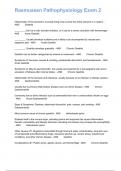Rasmussen Pathophysiology Exam 2
Inflammation of the stomach's mucosal lining (may involve the entire stomach or a region) -
ANS Gastritis
_________Can be a mild, transient irritation, or it cab be a severe ulceration with hemorrhage -
ANS Acute Gastritis
_________ Usually develops suddenly and is likely to be accompanied by nausea and
epigastric pain - ANS Acute Gastritis
_________ Gastritis develops gradually. - ANS Chronic Gastritis
Gastritis can be further categorized as erosive or nonerosive - ANS Chronic Gastritis
Symptoms of: Anorexia, nausea & vomiting, postprandial discomfort, and hematemesis. - ANS
Acute Gastritis
Symptoms of: May be asymptomatic, but usually accompanied by a dull epigastric pain and a
sensation of fullness after minimal intake. - ANS Chronic Gastritis
Inflammation of the stomach and intestines, usually because of an infection or allergic reaction -
ANS Gastroenteritis
Usually due to primary inflammatory disease such as crohns disease - ANS Chronic
Gastroenteritis
Commonly due to direct infection such as salmonella from raw or undercooked chicken or eggs
- ANS Acute Gastroenteritis
Signs & Symptoms: Diarrhea, abdominal discomfort, pain, nausea, and vomiting - ANS
Gastroenteritis
Most common cause of chronic gastritis - ANS Helicobacter pylori
Embeds itself in the mucous layer, activating toxins and enzymes that cause inflammation.
Genetic vulnerability and lifestyle behaviors (smoking and stress) may increase the susceptibility
- ANS Helicobacter pylori
Other causes of?: Organisms transmitted though food and water contamination, long-term use
of nonsteroidal anti-inflammatory drugs, excessive alcohol use, severe stress, autoimmune
conditions, and other chronic disease - ANS Gastritis
Complications of?: Peptic ulcers, gastric cancer, and hemorrhage - ANS Chronic Gastritis
,Rasmussen Pathophysiology Exam 2
Manifestations of?: Include indigestion, heartburn, epigastric pain, abdominal cramping, nausea,
vomiting, anorexia, fever, and malaise. Hematemesis and dark, tarry stools can indicate
ulceration and bleeding. - ANS Gastritis
Chyme periodically backs up from the stomach into the esophagus. Bile can also back up into
the esophagus. - ANS GERD (Gastroesophageal Reflux Disease)
These gastric secretions irritate the esophageal mucosa - ANS GERD (Gastroesophageal
Reflux Disease)
Causes of?: certain foods (e.g., chocolate, caffeine, carbonated beverages, citrus fruit,
tomatoes, spicy or fatty foods, and peppermint), alcohol consumption, nicotine, hiatal hernia,
obesity, pregnancy, certain medications (e.g., corticosteroids, beta blockers, calcium-channel
blockers, and anticholinergics), nasogastric intubation, and delayed gastric emptying - ANS
GERD (Gastroesophageal Reflux Disease)
Manifestations of?: heartburn, epigastric pain (usually after a meal or when recombinant),
dysphagia, dry cough, laryngitis, pharyngitis, regurgitation of food, and sensation of a lump in
the throat. - ANS GERD (Gastroesophageal Reflux Disease)
Complications of?: esophagitis, strictures, ulcerations, esophageal cancer, and chronic
pulmonary disease - ANS GERD (Gastroesophageal Reflux Disease)
Often confused with angina and may warrant ruling out cardiac disease - ANS GERD
(Gastroesophageal Reflux Disease)
Lesions affecting the lining of the stomach or duodenum - ANS Peptic Ulcer Disease (PUD)
Risk factors of?: being male, advancing age, nonsteroidal anti-inflammatory drug use (NSAIDs),
H. pylori infections, certain gastric tumors, and those for GERD. - ANS Peptic Ulcer
Disease (PUD)
Vary in severity from superficial erosions to complete penetration through the GI tract wall.
Develops because of an imbalance between destructive forces and protective mechanisms -
ANS Peptic Ulcer Disease (PUD)
Types of Peptic Ulcer Disease (PUD) - ANS Duodenal Ulcers
Gastric Ulcers
Stress Ulcers
, Rasmussen Pathophysiology Exam 2
Most commonly associated with excessive acid or H. pylori infections. Typically present with
epigastric pain that is relieved in the presence of food - ANS Duodenal ulcers
Less frequent but more deadly. Typically associated with malignancy and nonsteroidal
anti-inflammatory drugs. Pain typically worsens with eating. - ANS Gastric Ulcers
Develop because of a major physiological stressor on the body due to local tissue ischemia,
tissue acidosis, bile salts entering the stomach, and decreased GI motility. - ANS Stress
ulcers
Stress ulcers associated with burns - ANS Curling's ulcers
Stress ulcers associated with head injuries - ANS Cushing's ulcers
Most frequently develop in the stomach; multiple ulcers can form within hours of the
precipitating event. - ANS Stress ulcers
Often hemorrhage is the first indicator because the ulcer develops rapidly and tends to be
masked by the primary problem - ANS Stress ulcer
Complications of?: GI hemorrhage, obstruction, perforation, and peritonitis - ANS Peptic
Ulcer Disease (PUD)
Manifestations of?: epigastric or abdominal pain, abdominal cramping, heartburn, indigestion,
nausea, and vomiting - ANS Peptic Ulcer Disease (PUD)
Acute inflammation and necrosis of large intestine; it affects the mucosa and sometimes other
layers - ANS Pseudomembranous Colitis (C. Diff)
Causes of?: Exposure to antibiotics, patients with cancer, or post abdominal surgery
susceptible, mediated by bacterial toxins - ANS Pseudomembranous Colitis (C. Diff)
Manifestations of?: Diarrhea (often bloody), abdominal pain, fever, and leukocytosis - ANS
Pseudomembranous Colitis (C. Diff)
Inflammation of the vermiform appendix. Most often caused by an infection. Triggers local tissue
edema, which obstructs the small structure. As fluid builds inside the appendix, microorganisms
proliferate - ANS Appendicitis
The appendix fills with purulent exudate and area blood vessels become compressed - ANS
Appendicitis




